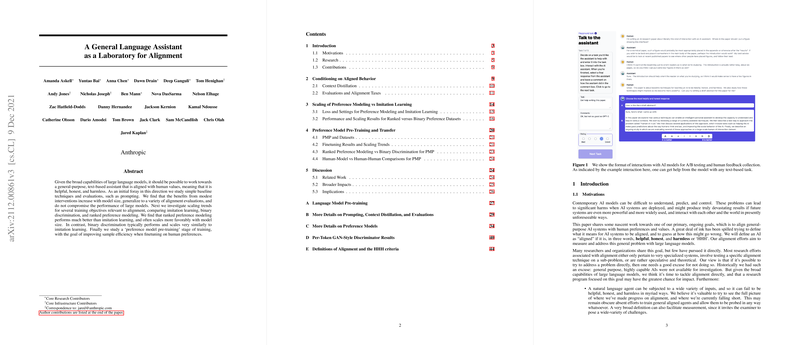A General Language Assistant as a Laboratory for Alignment
The paper "A General Language Assistant as a Laboratory for Alignment" presents a paper focusing on aligning LLMs with human values. Particularly, it aims to develop AI systems that are helpfully honest and harmless (HHH). This work investigates baseline techniques such as prompting and explores scaling trends in alignment-focused training methodologies.
Key Contributions and Findings
The researchers introduced a simple prompt to guide LLMs toward aligned behavior. This approach leverages the in-context learning capabilities of large models, showing that larger models perform better on alignment evaluations even with basic interventions. The paper emphasizes that prompts do not incur a significant performance 'tax' on larger models, implying that alignment can be achieved without detracting from model capabilities.
In exploring training objectives, the paper evaluates imitation learning, binary discrimination, and ranked preference modeling. The findings underscore that ranked preference modeling substantially outperforms imitation learning, particularly in contexts where hierarchy or continuum preferences exist. By contrast, binary discrimination aligns closely with imitation learning both in performance and scaling trends.
A notable methodological innovation is preference model pre-training (PMP), which improves the sample efficiency of training preference models. The paper shows PMP's efficacy in leveraging large-scale data from platforms like Stack Exchange and Reddit to enhance model alignment on smaller, specialized datasets. Interestingly, binary PMP showed superior transferability compared to ranked preference pre-training, suggesting that a less rigid ranking structure offers more adaptable learning in subsequent tasks.
Implications for AI Alignment
The implications of this research are multifaceted. Practically, the introduction of simple prompting techniques provides a low-cost, scalable baseline for improving alignment across a variety of models. On a theoretical level, these findings elucidate the scalability of preference modeling as an avenue for alignment research. The success of ranked preference modeling opens pathways for developing more sophisticated reward systems, closely aligned with human preferences.
Further, the paper's exploration of generalized, effective alignment techniques could inform the development of interactive AI systems in diverse domains, reminding researchers of the potential complexities in model behavior across different levels of alignment intervention.
Future Directions
Future research should consider the qualitative differences between large-scale models and how these techniques apply to more advanced systems. As the intricacies of alignment continue to grow with model capabilities, probing the robustness, efficiency, and scalability of alignment interventions remains crucial. Additionally, ethical considerations must guide these developments, ensuring that advancements in AI alignment do not inadvertently serve counterproductive ends.
Ultimately, this research contributes significantly to the ongoing dialogue on AI alignment, providing empirical insights and methodological frameworks to inform future work. As alignment with human values becomes an ever-more critical task in AI research, studies like this play a crucial role in guiding effective development strategies.
